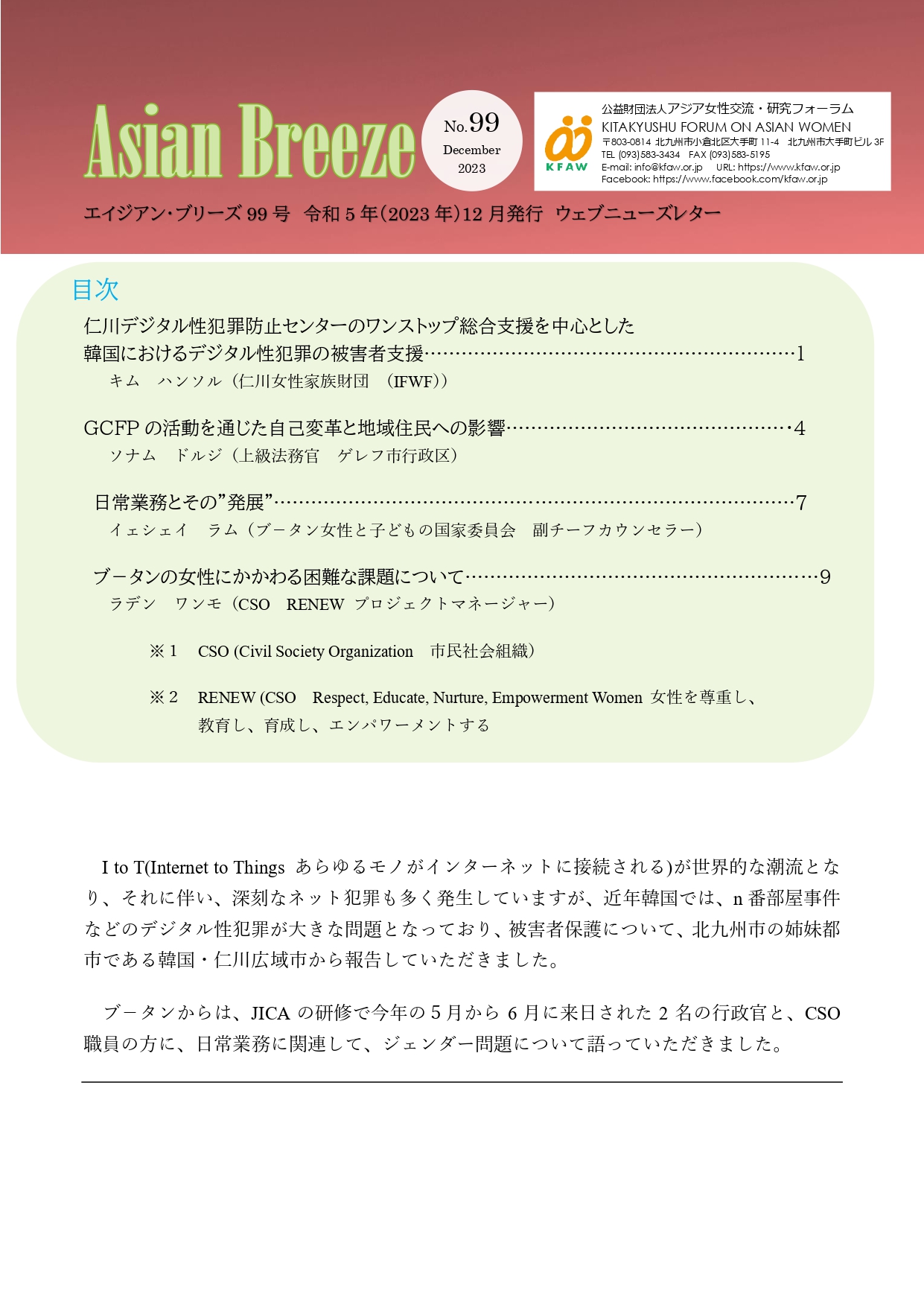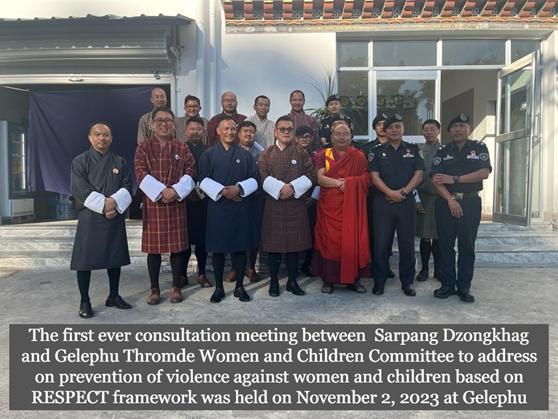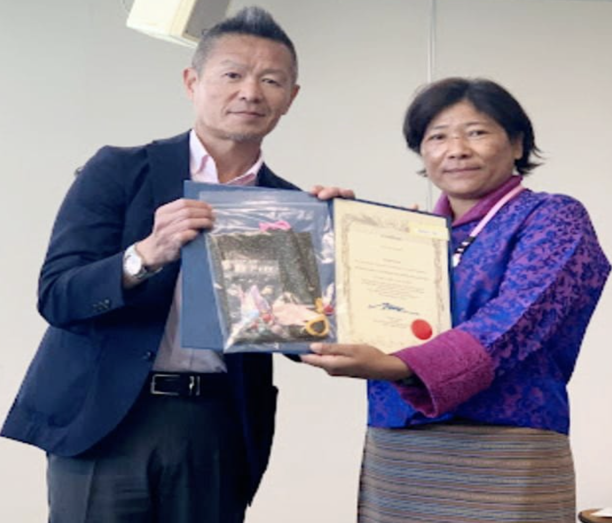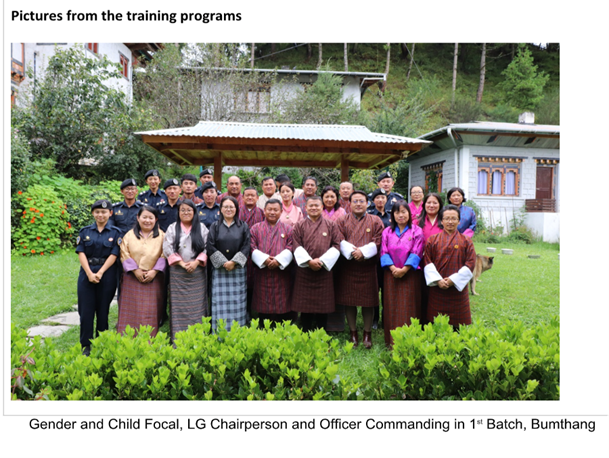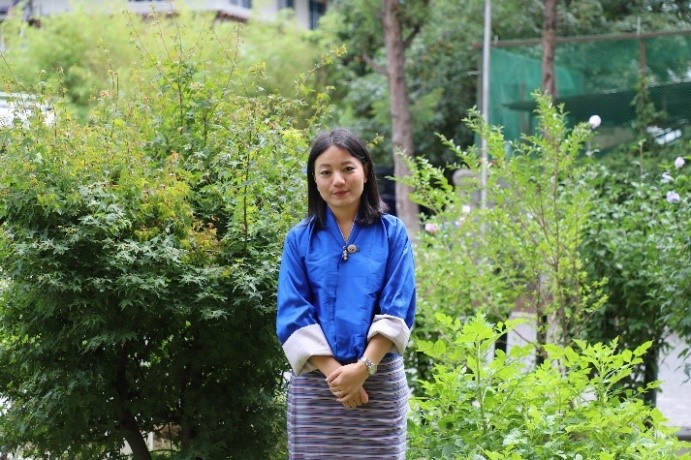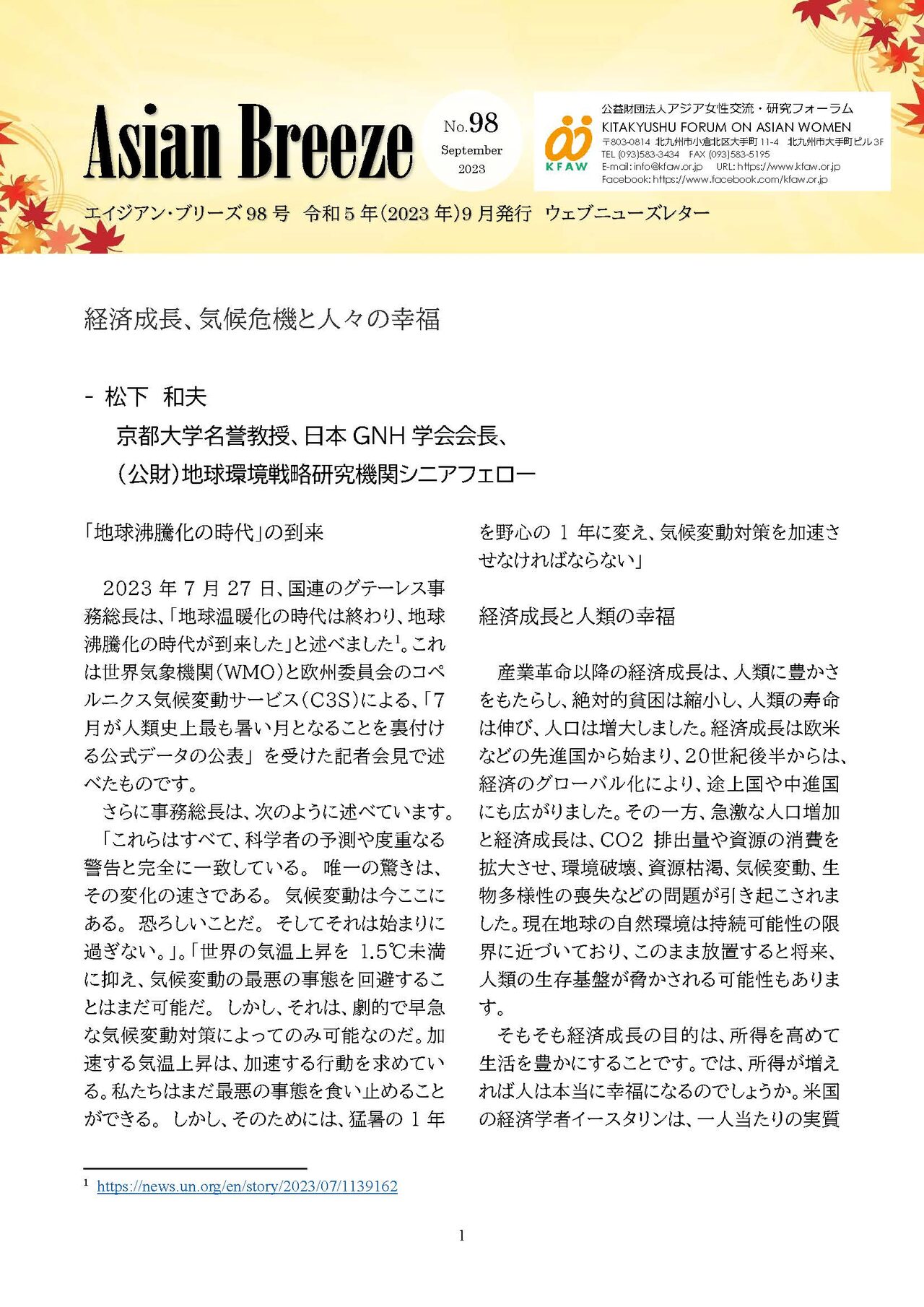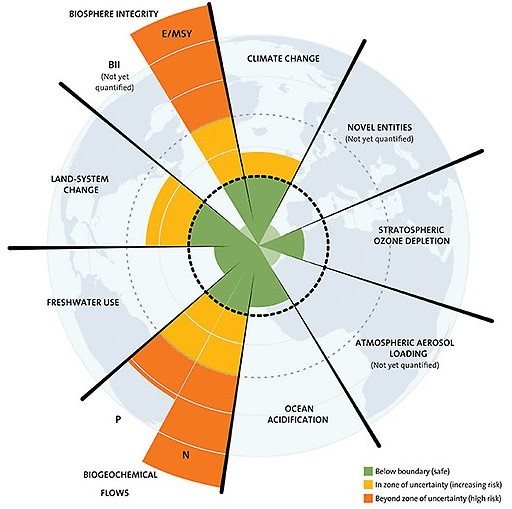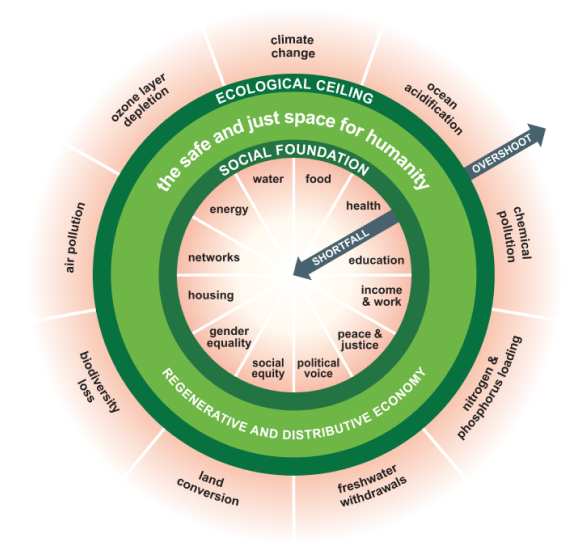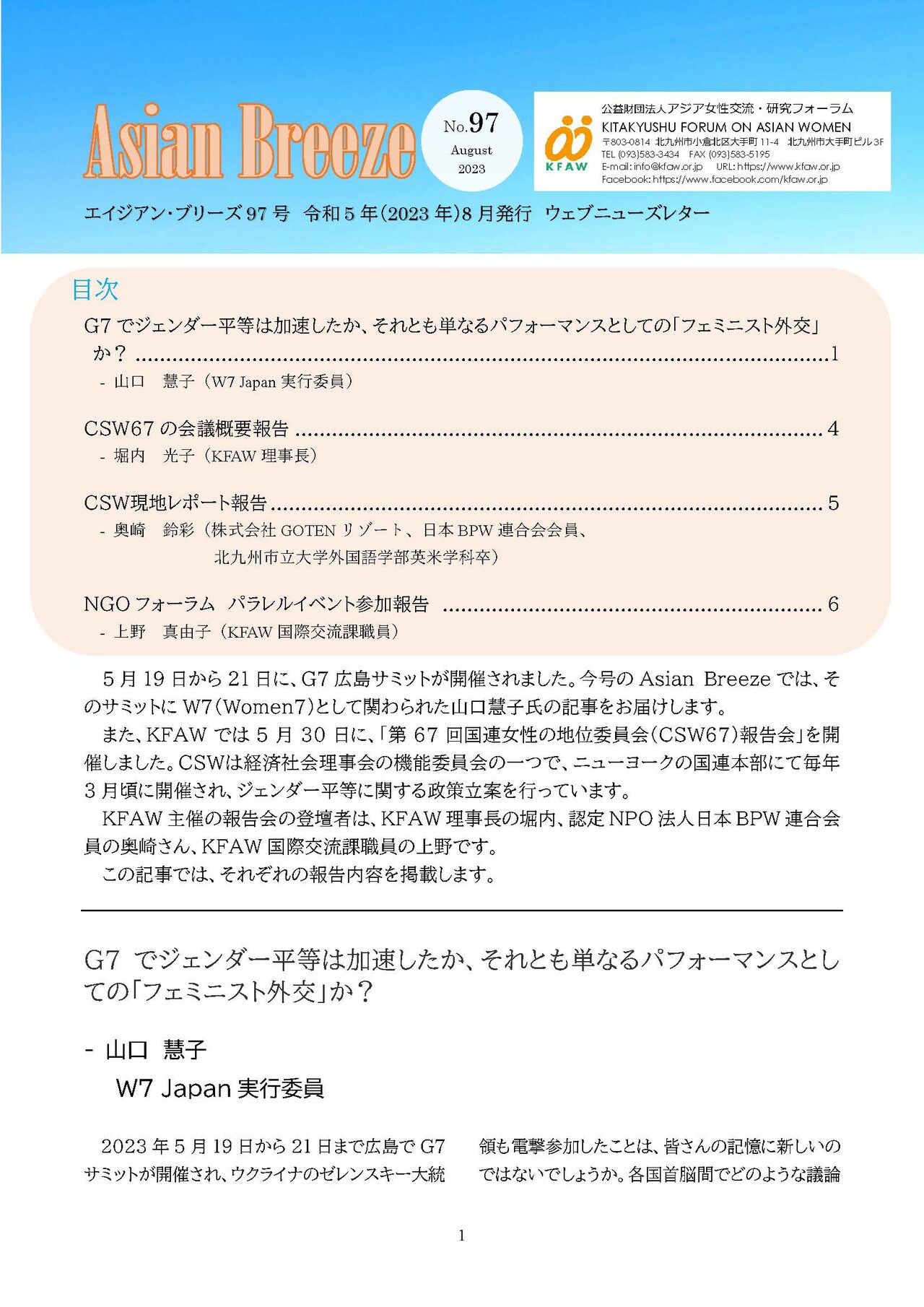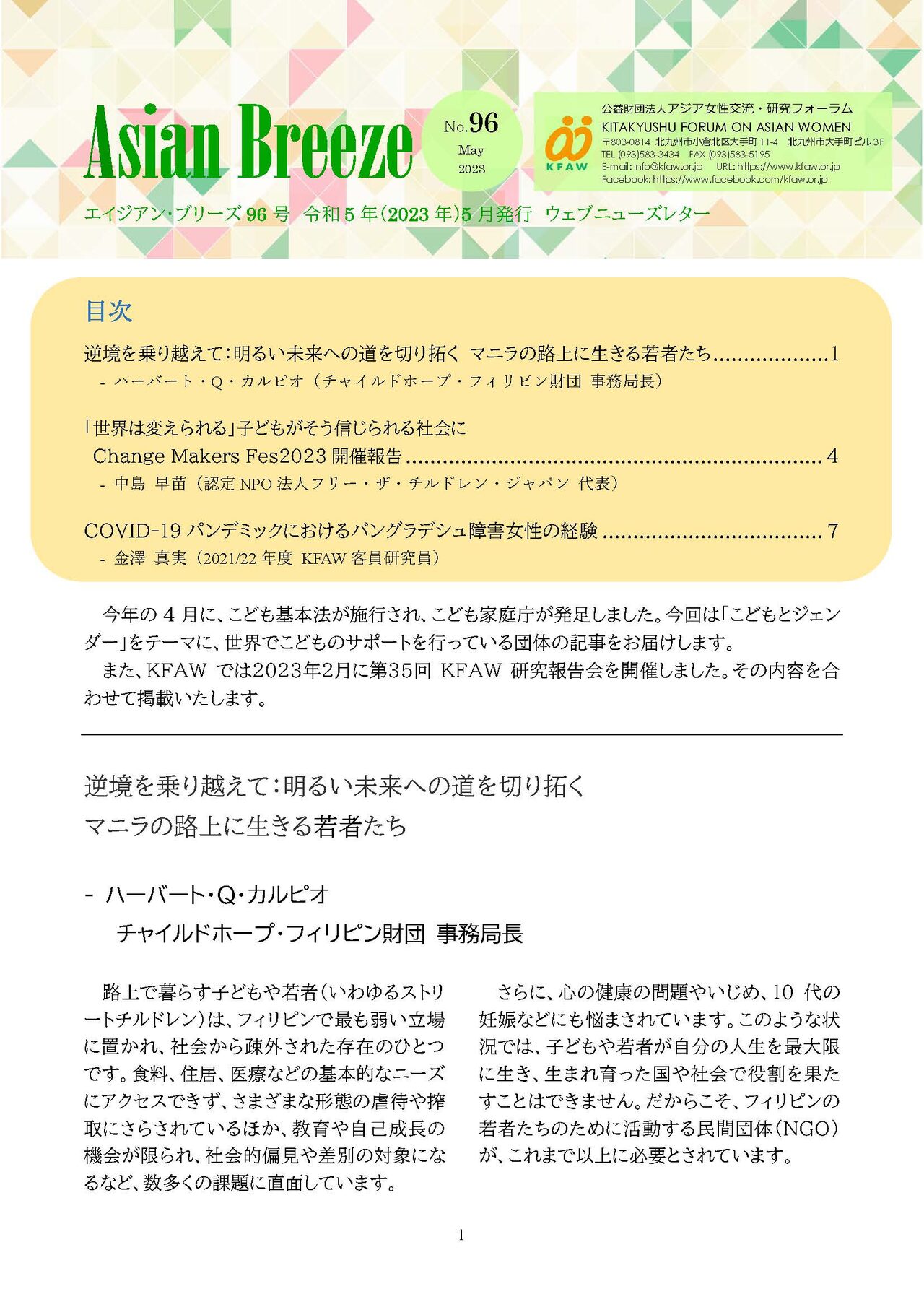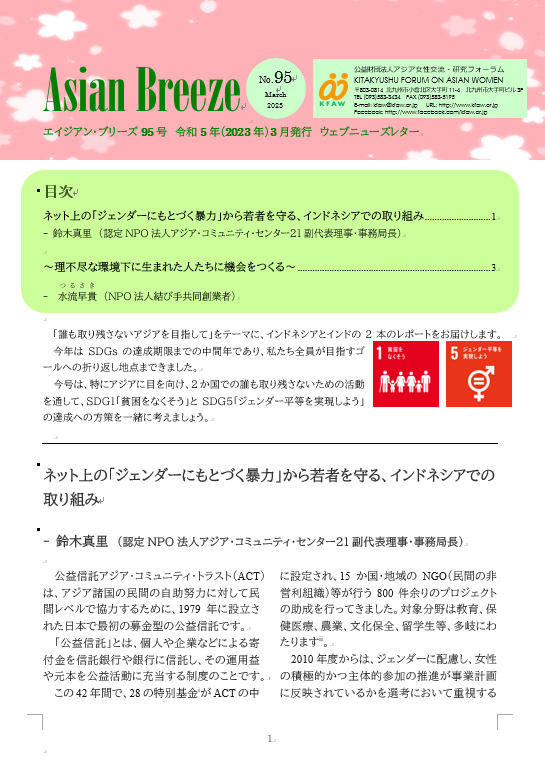
Contents
- Rice Cakes and the Status of Women in Philippines
-Patricia B. Licuanan (Former Philippines Minister of Higher Education 2010 to 2018) - Gender equality is key to achieving the 2030 Agenda for Sustainable Development
-Oda Yukiko (Officer , Japan Women’s Watch (JAWW))
In this milestone 100th issue, former Philippine Minister of Higher Education Paricia B. Licuanan, who was also active in the UN, leading the negotiations of the Beijing Declaration and Platform for Action at the UN Fourth Conference on Women, and has been involved in women’s higher education in the Philippines for a long time, talks about gender issues in the Philippines. She spoke about gender issues in the Philippines. Ms. Yukiko Oda, she was researcher of Kitakyushu Forum on Asian Women who has been involved in gender issues at universities and NGOs for a long time, also explains the keys to achieving the SDGs.
Rice Cakes and the Status of Women in the Philippines

Patricia B. Licuanan
Patricia B. Licuanan PhD is a social psychologist, educator, and women’s rights and empowerment activist. She has been professor and chair of the Department of Psychology and academic vice-president of Ateneo de Manila University and president of Miriam College. She has played leadership roles in the women’s movement both nationally and internationally serving as chair of the National Commission on the Role of Filipino Women(now Philippine Commission on Women) and the United Nations Commission on the Status of Women as well as NGO networks in the Asia and Pacific region. At the United Nations Fourth World Conference on Women held in Beijing, China in 1995, she led the negotiations on the Beijing Declaration and Platform for Action. She was Philippine Minister of Higher Education from 2010 to 2018.
Gender equality and women’s empowerment in the Philippines is supported by many factors. The formal policy environment recognizes the equality between women and men and the important role of women in national life. The Philippine constitution has an explicit gender equality provision. There are many significant and progressive laws such as the comprehensive Women in Development and Nation Building Act and more recently the Magna Carta of Women. The Philippines was the first country in Asia to have an Anti-Sexual Harassment Law which has recently been expanded in the Safe Spaces Act.
During the administration of President Corazon Aquino, the first Philippine Development Plan for Women was launched, followed by several successor plans. The significance of these national plans for women is that as companion to the Philippine Development Plan, they ensure that women, women’s issues, and women’s contributions are part of national planning and programming and the work of all government agencies. Government working for women has also been enhanced by the creation of the Gender Budget which sets aside 5% of the budget of all government agencies (including state colleges and universities) for programs on gender equality and women’s empowerment.
Beyond national policy, international covenants on women’s rights such as the Convention on the Elimination of All Forms of Discrimination Against Women and the Beijing Declaration and Platform for Action have played important roles. Aside from the Philippines being signatory to these, it must be noted that Filipino women, including 4 who have served as chair of the UN Commission on the Status of Women (UNCSW), played major roles in the crafting of these landmark documents.
After the Global Gender Gap Index of the World Economic Forum was established in 2006, the Philippines consistently placed in the top 10 for over a decade. Today the country’s rating has gone down but it remains in the top 20, the only Asian country on the list. And while the United States is celebrating its first woman vice president, the Philippines has had two woman vice-presidents and two woman presidents and some extraordinary women in high positions.
Along with legislation, policy, and leadership, gender equality and women’s empowerment is driven at the grassroots level by a strong and vibrant women’s movement, women NGOs that push for and support progressive laws and policies and make their voices heard on important issues.
The status of women in the Philippines is propelled and enhanced by what the women’s movement refers to as the “bibingka principle”. Bibingka, is a national delicacy, a rice cake made from glutinous rice flour, eggs, and a bit of sugar, topped with morsels of local white cheese, salted duck egg, and grated coconut. Making it is a time-consuming process that involves pouring the batter into a round pan with hot coal underneath, then placing more hot coal on top. In effect, the bibingka is cooked by the burning coal from below and above. Thus, the status of women has fire on top in the form of progressive and enlightened legislation, policy, and leadership and fire at the bottom in the form of well-organized, dynamic, and courageous NGOs.
So there is a lot working for women in the Philippines. But there are problems. Women outnumber men in school enrollment and graduation but these accomplishments do not necessarily result in better access to decent jobs nor parity in work and promotion opportunities. Men’s average wages are higher than that of women in both rural and urban areas and women are under-represented in top administrative and managerial positions and in political leadership.
Negative attitudes and stereotypes exist and operate in society. This is particularly obvious in politics where factors of entrenched discrimination operate. A large percent of the population believe that men make better political leaders than women. Thus women continue to be seriously underrepresented as candidates for public office although they make up at least half of the electorate. Violence against women is present in many forms—domestic violence, rape, sexual harassment, and misogynistic statements in public coming from top male leaders.
Therefore, advocacy and action for gender equality and women’s empowerment must continue. There is need to analyze and remedy the Philippines’ lowered ratings on the Global Gender Gap Index. There is need to understand how a visibly misogynistic leadership emerged and why it is being tolerated. The “bibingka principle” should be applied with greater fervor and determination.
Gender equality is key to achieving the 2030 Agenda for Sustainable Development

Oda Yukiko
Officer, Japan Women’s Watch (JAWW)
Former Co-facilitator, Gender Unit, Japan Civil Society Network on SDGs
Oda Yukiko has worked in the fields of research, education, development practice, and civil society as a researcher at the Kitakyushu Forum on Asian Women, a university faculty member, a JICA project expert and committee member, and an advocate. Her areas of expertise are gender and sustainable development, and she has been following the SDGs since their birth at the UN Conference on Sustainable Development (Rio+20) in 2012, through the adoption of Agenda 2030 at the UN in 2015, and the subsequent implementation in Japan from gender and civic perspectives. Her recent publications include ‘Environment, Climate Change and Gender Equality:How Have They Created Synergies?’ in International Women, No. 36, 2022.
The SDG Summit: halfway point to 2030
On September 18 and 19, 2023, the UN SDG Summit took place, bringing together heads of state every four years to conduct a comprehensive review of the implementation of the Transforming Our World: the 2030 Agenda for Sustainable Development (hereafter referred to as the SDGs), adopted by all United Nations Member States in 2015.
In his opening remarks at the Summit, UN Secretary-General Guterres stated, ‛Today, only 15 per cent of the targets are on track and many are going in reverse. Instead of leaving no one behind, we risk leaving the SDGs behind.’This follows the UN’s Sustainable Development Report 2023, Special Edition: Towards a Rescue Plan for People and Planet, which had pointed out the delay in progress of SDGs implementation using the expression ‛Promise in peril.’ The Sustainable Development Report (SDR) 2023, published by the Sustainable Development Solutions Network (SDSN), has also highlighted the slow progress, stating ‛not a single goal will be achieved by 2030 at the current rate.’
Based on this sense of urgency, the Secretary-General outlined what needs to be done in the remaining seven years, firstly to secure financing for the achievement of the SDGs and stressed the need to change the international financial architecture. He also identified six targeted areas where urgent transitions are needed: food, renewable energy, digitalization, education, decent work and social protection, and planetary crises, emphasizing that ensuring full gender equality is a cross-cutting perspective across all these areas. In this way, he enthusiastically inspired action to achieve the SDGs. The Global Sustainable Development Report (GSDR), a report by fifteen independent scientists appointed by the UN, centered on transforming the world, taking from the 2030 Agenda, and saw the SDGs implementation as a game-changer, viewing it as an opportunity to change the world.
Progress and challenges of the SDGs in Japan
The progress of the SDGs in Japan is evident in the number of people wearing SDG badges in business, government, or civil society, and the media offering special programs on the SDGs. Thanks to this, awareness of the SDGs in Japan is surprisingly high, at over 90%. However, despite the prominent level of awareness, Japan’s ranking by country, which indexes each country’s progress in achieving the SDGs, has fallen from 11th in 2017 to 21st in GSDR 2023. Goal 5, Gender Equality, is the leading goal where progress has not been made.
In Japan, the SDGs are implemented in accordance with the SDGs Implementation Guiding Principles (hereafter referred to as the Guiding Principles), led by the SDGs Promotion Headquarters headed by the Prime Minister. The Guiding Principles are to be revised in line with the UN SDG Summit, with the latest draft revision announced in November 2023 and called for public opinion, a new set of Guiding Principles will be announced in December 2023. Based on the Guiding Principles, an ‛SDGs Action Plan’ is prepared every year, and actions are taken accordingly, but the reality is that many of these plans are based on existing programs of ministries and agencies, So, it is difficult to say that they are plans to achieve the goals set out by the SDGs.
The most comprehensive review of progress is the Voluntary National Review (VNR), in which countries report at the High-Level Political Forum (HLPF) held annually at the UN. Japan’s most recent report was in 2021. To measure the progress of implementation, global indicators are defined in line with the 169 targets of the SDGs, and Japan’s corresponding data can be found on the website of the Ministry of Foreign Affairs (MOFA), but it is difficult to compare progress and understand the current situation compared to reports by the UN and other organizations because some data is not collected. Accountability remains in terms of verifying the progress of the SDGs in Japan.
Measuring progress on gender equality – gender mainstreaming and intersectionality
UN Women publishes an annual Gender Snapshot (hereafter referred to as the Snapshot) to examine the achievement of gender equality through the implementation of the SDGs. The Snapshot is informative for the promotion of the SDGs and gender equality in Japan in two ways. The first is that it specifically outlines progress and challenges in gender equality, not only through Goal 5, Gender Equality, of the SDGs, but also through all 17 Goals. This can be seen as a formulation of the preamble to the 2030 Agenda, which states the importance of mainstreaming gender perspectives to achieve the seventeen goals of the SDGs. The second feature of the Snapshot is that it presents an intersectionality perspective. Let us take a few goals from the Snapshot 2023 as examples.
Goal 9 of the SDGs on ‛Industry, Innovation and Infrastructure,’ presents gender-disaggregated data, including that women make up a quarter of those working in STEM (science, technology, engineering, and mathematics) and ICT fields, and that women account for only 17% of global patent holders. It further notes that women are at greater risk of being exposed to technology-facilitated violence and suggests the need to eliminate gender-based violence to achieve Goal 9. Gender-based violence is often referred to in Goal 5 and Goal 16 on Peace, Justice and Strong institutions, but the Snapshot suggests that it is also important for the achievement of Goal 9. In addition, Goal 9 introduces the finding that AI-based facial and voice recognition systems have more misclassified darker-skinned women compared to fair-skinned men, suggesting that the gender and racial bias of developers is a matter and drawing attention to the need for diverse people to be involved in the development.
Regarding Goal 11 on ‛Sustainable Cities and Communities,’the Snapshot projects that in 2050, 70% of the world’s women and girls will live in cities and one-third of them in slums or informal settlements, emphasizing the need for public investment in the settlement sector from a gender equality perspective. Then, Goal 11 leads toward the right to housing for women with disabilities by introducing data that women with disabilities account for 18% of all women, but only 27% (52 out of 190) countries have protection and promotion of women’s rights in their national policies on people with disabilities. Some local governments in Japan have included the perspective of persons with disabilities in their city planning, but it is necessary to verify how many of them have raised gender perspectives.
Regarding Goal 13 on ‛Climate Change,’ not only does the section present gendered data that 160 million women and girls will be at risk of extreme poverty and 240 million women of food insecurity by 2050 due to climate change. It also reminds us that countries are obliged to include a ‘gender perspective’ in their Nationally Determined Contribution (NDCs) under the Paris Agreement of the UN Framework Convention on ‛Climate Change.’ The report presents data showing that only fifty-five countries refer to gender equality in their NDC and twenty-three countries position women as agents of change. Thus, it shows that the achievement of Goal 13 ‛Climate Change’is related to Goal 1 ‛No Poverty’ and Goal 5 ‛Gender Equality.’ The Snapshot 2023 has a particular focus on older women, drawing attention to the issue of violence against older women as well as poverty among older women. It reminds us that it is Japan, a hyper-aged society, which needs to mainstream the issue of the human rights and dignity of older women in the implementation of SDGs. In this way, the Snapshot attempts to show the diverse issues of diverse people, not just gender disaggregated data. It can serve as a reference for examining the implementation of the SDGs in Japan.
Lastly, one example of progress made on gender through the implementation of the SDGs in Japan can be seen in the data on awareness and understanding of each theme of the SDGs.
According to a survey, awareness of gender equality was 90.2%, ranking second after food loss, and in terms of understanding, it ranked third after food loss and renewable energy (22.8%). At the very least, we can say that the SDGs have contributed to removing allergies to the term gender in Japan. As acknowledged in the Draft Revised Guiding Principles for the Implementation of the SDGs, Japan is severely lagging behind on Goal 5 ‛Gender Equality.’ This means that if Japan accelerates its efforts and achieves results in gender equality in the latter seven years to 2030, it could lead the global movement towards the post-SDGs as a country that has tackled difficult issues. The key to Japan’s achievement of the SDGs lies in its gender equality efforts.
Thank you for reading. Any comments and suggestions are welcome.
Email us! →info@kfaw.or.jp

